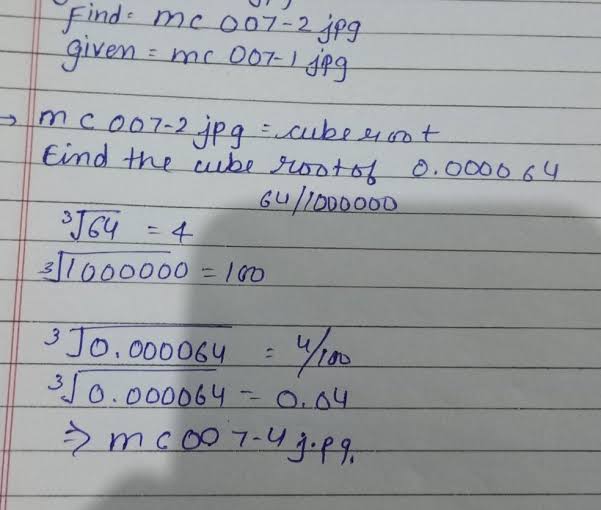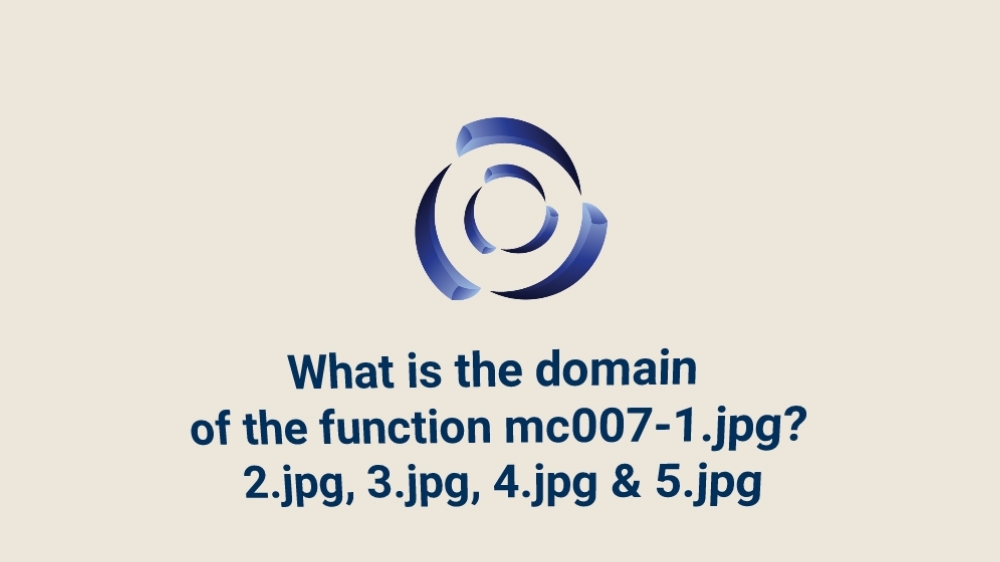What is the domain of the function mc007-1.jpg? mc007-2.jpg mc007-3.jpg mc007-4.jpg mc007-5.jpg. All answers, details & video below.
What is the domain of the function mc007-1.jpg? mc007-2.jpg mc007-3.jpg mc007-4.jpg mc007-5.jpg
- The value of mc007-2.jpg is mc007-4.jpg.
- Given: mc007-1.jpg
- To Find: mc007-2.jpg
- Solution:
- mc007-2.jpg = cube root
- We need to find the cube root of 0.000064
- 0.000064 = 64 /1000000
- 1st cube root of 64,
- 64 = 2 * 2 * 2 * 2 * 2 * 2
- 64 = 2³ * 2³
- 64 = ( 2 * 2)³
- 64 = 4³
- ∛64 = 4
- the cube root of 1000000,
- 1000000 = 10 * 10 * 10 * 10 * 10 * 10
- 1000000 = 10³ * 10³
- 1000000 = (10 * 10)³
- 1000000 = 100³
- ∛1000000 = 100
- hence ∛0.000064 = 4/100
- ∛0.000064 = 0.04
- ⇒mc007-4.jpg
- Therefore, the value of mc007-2.jpg is mc007-4.jpg.
What is the domain of the function mc007-1.jpg? 2.jpg, 3.jpg, 4.jpg & 5.jpg . So how do you find the domain of a function? So let’s take two X – 7 functions. What is the domain of this function? What is the list of all possible X values that can be found in this function? Once you have a linear function like the one listed, the domain is arbial numbers, so an X range representation can be anything.

It can be in any range of values from negative Infinity to positive Infinity. Likewise, if you have a quadratic function like X ^2 + 3 X minus five, the domain is still arbial numbers. Or if you have a polynomial function like two X ^3 -, 5 X squared plus seven X – 3, the domain is the same. Arbial numbers.
What is the domain of the function mc007-1.jpg? mc007-2.jpg mc007-3.jpg mc007-4.jpg mc007-5.jpg. / So if you have no fractions or square roots, but just a simple polynomial function, that will be the domain. But what if we have a rational function? Let’s say we have a fraction like 5/X -, 2, how can we find the interval? I mean the area of this function, not its range. In this function X can be anything.
Accept a value that will produce zero in the denominator. So for example X -. 2 can’t be equal to 0, so X can’t be a positive 2 because if you put two 2 -, 2 is 0, and when zero in the denominator is undefined, you can have a vertical asymptote. For rational functions, set the denominator to a value not equal to 0 and then you can find the value of X.
What is the domain of the function mc007-1.jpg? 2.jpg, 3.jpg, 4.jpg & 5.jpg / So how do you represent it? Are you using range notation? So if we draw a number line, X could be anything other than 2:00. So we’ll have an open circle at two. It can be greater than two or less than two. To the left, you have negative Infinity, to the right, positive Infinity. So for the left side X could be anything from negative Infinity to two, but excluding two.
Or it could be anything from 2:00 to Forever and so you can write the domain using the end of all impressions. Let’s try another example for this example. Let’s say we have three X -, 8 / X ^2 -, 9 X plus 20. So we have another rational function, as can be seen from the fraction we have.
What is the domain of the function mc007-1.jpg? So what should we do as before? By the way, you can try this problem if you want. We need to set it not equal to 0. So X ^2 – 9 X plus 2 cannot equal 0. So how can we find X values that will give zero in the denominator? What we need to do is factor this trinomial. So what you want to do is find 2 numbers multiplied by 20.
But it adds up the middle coefficient – 9. So we know that 4 * 5 is 20. But their total is 9:00. So we have to use -, 4 and -, 5, which still multiplies a positive 20 but adds up to -, 9. Therefore X – 4 * X – 5 cannot equal 0. So we can say that X -, 4 cannot be. With 0 and X -, 5 cannot be zero in the first. Let’s add 4 to both sides.
What is the domain of the function mc007-1.jpg? mc007-2.jpg mc007-3.jpg mc007-4.jpg mc007-5.jpg. So X cannot be 4 and 1X cannot be 5 for 2. Now how do we represent this in ineval notation? What I want to do is plot everything on a number line. If X isn’t equal to 4, I’m going to put an open circle and it can’t be equal to 5 either, but it could be anything else.
Now let’s write the domain. So from this part, it goes from negative Infinity to four, but it includes all four. And then unity. We have the second segment going from 4:00 to 5:00, and then we merge the last segment, which is five, to Infinity. So X could be anything but four and five. Now what about this example?
Two X – 3 / X ^2 + 4 go ahead and find the domain. Let’s start by setting x ^2 + 4 not equal to 0. So if we subtract both sides by 4:00, this cannot be X squared -, we get 4. Now that will never happen. When you square a number, you will get a positive number, not a negative number.
What is the domain of the function mc007-1.jpg? – For example, 3 * 3, nine – 3 times -. 3 is plus 9, so X squared never equals -. 4. So no matter what X value you choose, the denominator will never be 0. If you put in two, your denominator will be 2^2 + 4, so 8. will be 8. If you put the zero, it will be 4. The denominator will never equal zero, so that’s why.
For this particular rational function, they are all real numbers. Its scope is from negative Infinity to positive Infinity. What if you run into a square root problem now? For example, what is the domain of sqrt X -,4? How can we now find the answer for square roots or any root where the index number is even?
It cannot contain a negative number. If it’s weird, it could be anything. R1 numbers. But for even radicals or even radicals with an index number, you must set the inside greater than or equal to 0. It cannot be negative. All we have to do for this is add 4 to both sides so X is equal to four or greater to represent that with a number line this time we’re going to have a closed circle.
It can be equal or greater. So we’re going to shade it to the right. So on the right is positive Infinity. So the domain will be from 4:00. End / What is the domain of the function mc007-1.jpg? mc007-2.jpg mc007-3.jpg mc007-4.jpg mc007-5.jpg.
- There is no unique or exclusion constraint matching the on conflict specification
- What Percent Of A Standard Normal Model İs Found İn Each Region? Draw A Picture First.
- What İs The Domain Of The Function Shown İn The Mapping?
- Agarose gel electrophoresis separates dna fragments by ____.
- How Many Resonance Structures Exist For The Formate İon Hco2

